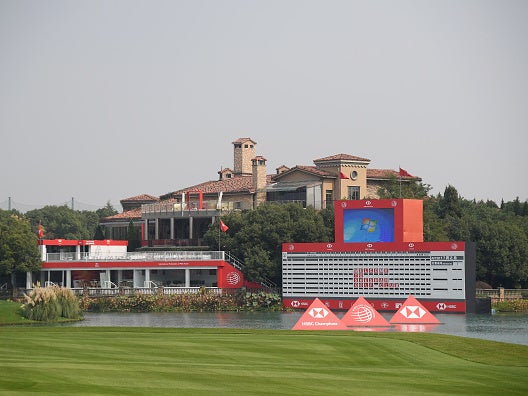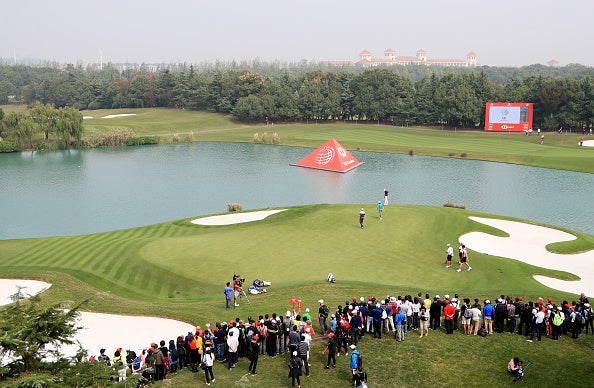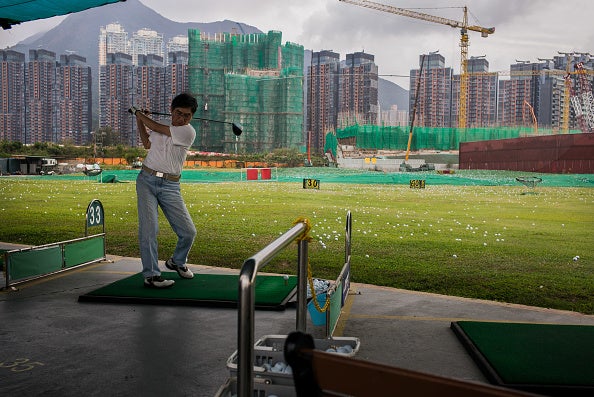In China, golf has come to encapsulate a country grappling with its own identity
Golf maps China’s emerging bubbles of individual wealth like ancient cartography, plotting divides in class and culture as courses erode ever further into the landscape, writes Tom Kershaw


Your support helps us to tell the story
From reproductive rights to climate change to Big Tech, The Independent is on the ground when the story is developing. Whether it's investigating the financials of Elon Musk's pro-Trump PAC or producing our latest documentary, 'The A Word', which shines a light on the American women fighting for reproductive rights, we know how important it is to parse out the facts from the messaging.
At such a critical moment in US history, we need reporters on the ground. Your donation allows us to keep sending journalists to speak to both sides of the story.
The Independent is trusted by Americans across the entire political spectrum. And unlike many other quality news outlets, we choose not to lock Americans out of our reporting and analysis with paywalls. We believe quality journalism should be available to everyone, paid for by those who can afford it.
Your support makes all the difference.In 1985, Malcolm Forbes purchased a bottle of Rothschilds Chateau Lafite, believed to have been taken from Thomas Jefferson’s cellar, for a then world record $156,000. In 2010, at an auction in Hong Kong, an unidentified Asian businessman broke that figure by purchasing three bottles of Lafite for $234,000 each.
Needless to say, by the seeds of grape and aristocracy, the robust Bordeaux has a body hard to come by. Unless you examine the deep oak-veneered wine racks of communist China’s country clubs that is, where even the price of a bottle wilts in comparison to membership fees.
In the world’s most polluted city – Shanghai – the most popular couture are hospital white pollution masks. But 45 minutes south of the city centre at Sheshan Golf Club the only whites on display are the caddies’ peculiar plastic helmets and matching gloves befitting a snooker referee or Michael Jackson’s right hand.

The 14-year-old golf club is a secluded oasis of evergreen jungle, immune to Shanghai’s grey haze, where pure oxygen is reserved exclusively for the rich. The course is lined by 60,000 trees, each with pride of place in Chinese mythology like a neo-Oriental nirvana.
The Yulan Magnolia, a mainstay of Buddhist gardens for two millennia; the ornamental Osmanthus, which according to lore was first grown on the moon; the 1,000-year-old Ginkgo on the fourth hole ascending into the sky like a herbaceous sibling to the city’s Oriental Pearl Tower.
There are 60 trees to every member at Sheshan. The joining fee when it was first opened in 2004 was less than £30,000. Today it is around £300,000. The terracotta-roofed Tuscan imitation villas beneath the canopy can sell for up to £30m and are amongst the most valuable area of retail property in the world.

The clubhouse is complete with a cigar room where Rothschilds’ illustrious bottles are available via waitresses who can be only be described as being of a genetically blessed persuasion. However, while it all might sound very godfather to a 17th Century English gentleman’s club, the men within are nouveaux riche rather than old money.
GPS golf watches are but a slight second to Rolexes, clubs are purchased by price as opposed to feel, and clothes are always designer – anything else and you may as well be naked. Many of the men don’t even play golf or have only just taken it up. Membership is purely a symbol of status, or – preferably – social supremacy. A boorish example of the growing gulf between classes as the ruling Communist Party fails to stamp out the influence of the capitalist West.
That polarity is evident on the journey to any of China’s havens for golfing hedonists. The muddied roads winding towards them are not shaded by magnolias but hazy fog. There are rural villages of primitive wooden huts where drinking water is boiled to detoxify it and families can be seen squatting over drooping crops by the roadside.
1.5 million cubic metres of such land was dug and displaced to create the 360-acre complex in Shanghai. In China, if developers can’t force the villagers out via corrupt officials, they suffer the unwelcome burden of actually having to build them a new one after strong-arming rural communities into sale.
However, such plans are rarely discussed openly as in the year Sheshan opened, China’s then president, Hu Jintao, banned the construction of further golf courses. Hu wanted to preserve the dwindling arable lands being overtaken and protect groundwater from pesticide pollution – it’s said that one golf course can use the same amount of water needed by 600 rural villages.
Yet, despite Hu’s ostensibly hardline approach, the safeguards were rarely heeded. In fact, just days after the president made his announcement, a club in Beijing announced they were planning to pay Tiger Woods over £11m to redesign their course.
Over the following eight years, more courses were built in China than in any other country in the world and one could be found in all but one of China’s 32 provinces and regions – Tibet being the only exception.

Golf was a taboo luxury, a financial fetish without the sexual splendour. And although the sport was portrayed as a pastime exclusively for the bourgeois, take a trip to any course and golfers could be seen playing under floodlights until two in the morning. At the modern golf ranges in central Shanghai teems of 20 to 30-year-olds could be seen boasting full-sized tour bags. Golf wasn’t a sport only played by the rich, it was played by those who were preempting or simply pretending to be.
A clampdown did somewhat occur when president incumbent Xi Jinping took power in 2012. After targeting drugs, prostitution and gambling, Xi took the obvious next slab and advanced the Communist Party’s failing cold war against golf, closing 111 clubs which were improperly using groundwater and arable or protected land while restrictions were placed on a further 65 courses.
But it wasn’t rural villagers for whom Xi held concern. It was the businessmen who traded bribes with government officials over bets on birdies and bogeys. The unscrupulous entrepreneurs who greased officials palms over pitch shots at golf courses they couldn’t otherwise afford. “Like fine liquor and tobacco, fancy cars and mansions, golf is a public relations tool that businessmen use to hook officials,” one state-owned newspaper said.

The president prohibited the 88 million members of his Communist Party from playing golf and even creating an online portal where the public could inform on government officials seen or even suspected of being golfers which often resulted in arrests.
Yet despite the supposed affront on the sport, the likes of Sheshan Golf Club have been left mysteriously untouched by Xi. In fact, the Chinese state is now dispensing huge amounts of money into an Olympic golf programme and, at one school in Beijing, golf etiquette is even taught as part of a curriculum to younger children to instil manners.
Even more strange is that there is actually a functioning PGA run China Series Tour which featured 14 events this year, all with a prize fund of at least £168,000 pounds. In fact, the winner of this year’s Order of Merit was a 28-year-old Englishman by the name of Callum Tarren hailing from none other than Darlington, County Durham and his success has now earned him automatic status on to America's PGA Web.com Tour.

And on a grander scale still, there are areas such as Mission Hills in the Guandong province - the largest golf resort on earth with 12 courses - where the list of course designers reads like the engravings on a major trophy: Jack Nicklaus, Nick Faldo, Ernie Els, Vijay Singh.
This week's HSBC sponsored money-spinning tournament is taking place at Sheshan for the 13th successive year. The prize purse for this year’s tournament is $10m - almost 62 bottles of that Rothschilds Château Lafite Ribena plonk.
Golf maps China’s emerging bubbles of individual wealth like ancient cartography, plotting divides in class and culture as courses erode ever further into the landscape. The contrast of a country which within itself lives two alternate identities, and perhaps even a third portrayed to the western world.
Former world No 1 and Ryder Cup winner Martin Kaymer summed up Sheshan best when explaining why it was his favourite course in Asia. Because “it’s like you’re not even China.”
Join our commenting forum
Join thought-provoking conversations, follow other Independent readers and see their replies
Comments